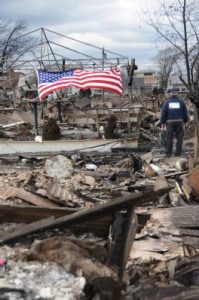
Hurricane Sandy hit the Jersey shore and then wrapped around through the state of New York affecting West Virginia, as well as parts of Pennsylvania and Connecticut. The storm came is as a tropical storm and brought with it a tremendous amount of water resulting in flooding in many areas.
Interesting Flood Facts
- Water weighs approximately 1,700 pounds per cubic yard.
- From 2002 to 2011, flood insurance claims averaged over $2.9 billion per year.
- Anyone can be financially vulnerable to floods. People outside of high-risk areas file over 20% of National Flood Insurance Program [NFIP] claims and receive one-third of disaster assistance for flooding.
- When your community participates in the Community Rating System (CRS), you can qualify for an insurance premium discount of up to 45%.
- Between 1978 and 2010, the NFIP has paid over $36.9 billion for flood insurance claims and related costs.

The average residential flood policy costs about $600 per year; these flood policies offer a Residential Claim Limit of $250,000, including $30,000 in Increased Cost of Compliance ( ICC) coverage. This is often not nearly the amount to make one whole again; therefore, without “excess flood coverage” many people are upside down after a flood loss. Government agencies are currently working to come up with a formula to allocate costs in undeterminable slab claims.
The FEMA Map Center is one of the first places to start looking for flood zone determinations in your area. From there one can make decisions as to whether or not to rebuild and the regulations that may or may not allow for rebuilding.
Another important resource is a properly filled out Elevation Certificate; this will help determine the elevation requirement for a particular property. If you are located in a flood zone, it is important to determine the required elevation for that zone. Keep in mind that very often after a significant flood event, elevation requirements can change.
These changes are based on public feedback and evaluation of damage received in a particular area. The changes may include a Freeboard requirement, which is an additional elevation requirement to the already imposed elevation requirements for the 20,200 communities enrolled in the NFIP. The more a community exceeds the minimum requirements of the NFIP, the lower the bill is based on the Community Rating System. This will be increasingly important as the levels of subsidies are decreased in an effort to make the NFIP program actuarially sound.

Some flood-prone areas also impose what is known as the 50% Rule. Basically, the 50% Rule states that, by ordinance, any property prone to flooding, if damaged by any cause whereby the cost to rebuild is more than 50% of the value of the residence, then the residence must be brought up to the current building code, including elevation requirements. In many cases, this makes it so that it is not financially feasible to restore these residences. Another important issue to keep in mind is that with flood insurance policies there is not an allowance for Loss of Use for being out of the subject property while repairs are being made; this can be an added expense depending on the time it takes to rebuild. Visit Floodsmart.gov for more information.
Complete General Contractors, Inc. specializes in hurricane damage restoration from residential, commercial, industrial and by municipality. John Minor has worked post-hurricane sites since Opal in 1995; his experience is far reaching – from the Carolina’s to Texas and all along the coast of Florida. The staff of Complete can meet with you to review your preparedness plan, and we will be there afterwards should you ever need us. We specialize in the actual restoration, prevention, as well as, dispute resolution of a claim. Call the company the pros choose – call Complete.
This information should not be substituted for professional legal advice; consult with your lawyer for legal advice and ask your insurance professional to discuss the details of your policy and insurance needs.
